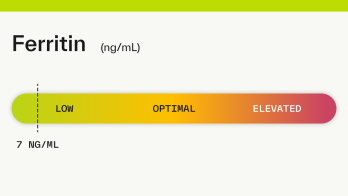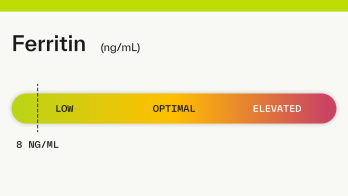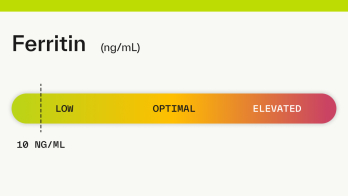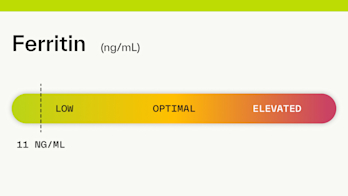Ferritin overview
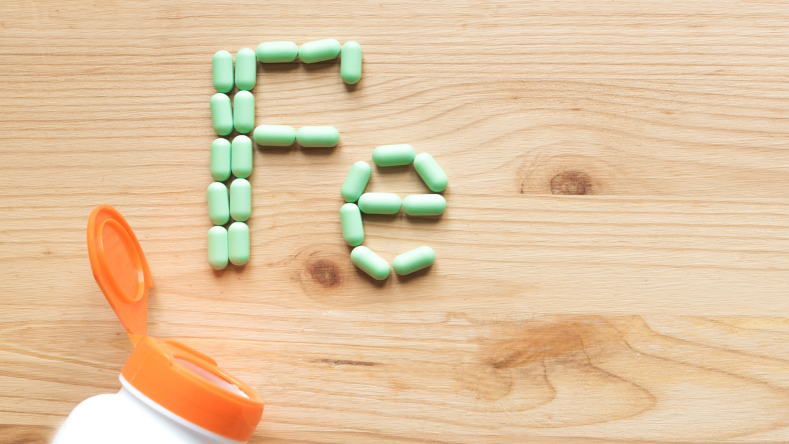
Contents
What is the ferritin test? What does the ferritin test measure? What do your ferritin results mean? What factors impact ferritin levels? Groups at risk for low ferritin levels Groups at risk for high ferritin levels Diet & lifestyle strategies shown to improve low ferritin levels Medications and supplements used to improve ferritin levelsWhat is the ferritin test?
The ferritin test measures the amount of ferritin, a protein that stores iron, in your blood. The test can be used to help diagnose iron deficiency anemia, hemochromatosis, liver disease, and Adult Still’s disease [1]. High ferritin levels may also indicate inflammation.
What does the ferritin test measure?
The ferritin test measures the amount of ferritin in your blood, a protein in the blood that stores iron and reflects your body’s iron levels. The more ferritin in your blood, the higher your iron stores. Your body’s iron reserves affect your energy level, sports performance, and immunity.
What do your ferritin results mean?
Normal ferritin ranges for adults differ between males and females. At Elo, ferritin status is classified as follows:
Low: <30 ng/mL for males; <20 ng/mL for females
Optimal: 30-300 ng/mL for males; 20-200 ng/mL for females
Elevated: 300-400 ng/mL for males; 200-400 ng/mL for females
High: >400 ng/mL for males and females
Low results
Low ferritin levels are <30 ng/mL for males and <20 ng/mL for females. Low ferritin levels may indicate iron deficiency, and possibly anemia. This can hinder sports performance, cognition, and immunity.
Optimal results
Optimal ferritin levels are between 30-300 ng/mL for males and 20-200 ng/mL for females. Optimal ferritin levels typically indicate adequate iron intake and absorption from the diet. Iron is essential for the production of hemoglobin, a protein in red blood cells that carries oxygen, as well as for the synthesis of certain hormones [ 3
Elevated results
Elevated ferritin levels are 300-400 ng/mL for males and 200-400 ng/mL for females. Elevated ferritin levels can be related to other health conditions such as hemochromatosis (a condition that causes your body to absorb too much iron from food), rheumatoid arthritis, hyperthyroidism, type 2 diabetes, liver disease, and some forms of cancer. Elevated ferritin may also reflect inflammation.
High results
High ferritin levels are >400 ng/mL for both males and females.
Similar to elevated levels, high ferritin levels can be seen in several health conditions and is a marker of inflammation. Some of these include hemochromatosis, rheumatoid arthritis, hyperthyroidism, type 2 diabetes, liver disease, and some forms of cancer. Diagnosis of these conditions typically requires additional testing.
What factors impact ferritin levels?
Numerous factors impact ferritin levels, including [ 2
Diet: Diets low in iron put you at greater risk of having low ferritin levels.
Your ability to absorb iron: Intestinal surgeries and disorders, like celiac disease, can reduce your body’s ability to absorb iron from digested food, leading to low ferritin levels and possibly iron-deficiency anemia.
Heavy menstruation: Heavy menstrual bleeding increases your body’s iron needs and can lower ferritin levels.
Heavy athletic training: Intense physical training also increases your body’s iron needs and can lead to a drop in ferritin.
Pregnancy: Pregnancy increases iron needs which can reduce ferritin levels.
Alcohol abuse: Alcohol intake has been shown to increase ferritin as well as serum iron levels [
4
].Inflammation & obesity: High levels of inflammation, caused by infection and chronic diseases like obesity, increase ferritin production and limit the amount of iron available for red blood cell production [
5
].Certain diseases & conditions: Diseases and health conditions can affect ferritin levels differently.Some can increase serum ferritin, includinghemochromatosis, rheumatoid arthritis, type 2 diabetes, hyperthyroidism, liver disease, Adult Still’s disease, leukemia, and Hodgkin's lymphoma. Other conditions like ulcerative colitis, Celiac disease, Crohn’s disease, colon cancer, and peptic ulcers can lower ferritin levels.
Groups at risk for low ferritin levels
Some groups of people have an increased risk of low ferritin and iron deficiency [ 6
Women. Women lose blood during menstruation, putting them at greater risk for low ferritin. Pregnancy also increases a woman’s risk for low ferritin as iron needs increase significantly during this time.
Infants and children. Infants, especially those who were low birth weight or born prematurely may be at risk of low ferritin (iron deficiency), especially if they are breastfed. Children are also at risk as they have high iron needs to support growth and development.
Vegetarians and vegans. People who don't eat meat may have a greater risk of iron deficiency anemia if they don't get enough dietary iron from other sources.
Frequent blood donors. People who routinely donate blood may have low ferritin since blood donation can deplete iron stores.
Groups at risk for high ferritin levels
Several health conditions may lead to increased ferritin and iron levels, including [ 6
Hyperthyroidism: An overactive thyroid gland produces high amounts of ferritin.
Hemochromatosis: An inherited disorder that causes your body to absorb too much iron from the food you eat.
Alcohol abuse: Alcohol intake has been shown to increase ferritin as well as serum iron levels [
4
].Liver disease: Liver disease, particularly non-alcoholic steatohepatitis (fatty liver), reduces liver function and hepcidin production, a hormone that regulates how your body uses iron.
Adult Still’s Disease: An immune-mediated disease notable for rash, inflammatory arthritis, and high ferritin levels [
7
].Porphyria: This group of disorders affects the production of heme, a component of hemoglobin, and is associated with higher iron (ferritin) levels.
Certain cancers: High ferritin commonly occurs with certain cancers including leukemia and Hodgkin lymphoma [
8
].
Diet & lifestyle strategies shown to improve low ferritin levels
You can naturally boost ferritin levels by increasing your intake of iron from foods. Here are some ways you can get more iron from your diet.
Eat more lean meat. Research has shown that eating lean meat once per day can increase ferritin levels, so if you choose to eat meat, it’s encouraged to eat a variety of red and lean meats [
9
].Pair iron with vitamin C. Vitamin C increases the absorption of non-heme (plant-based) iron. Squeeze lemon over dark leafy greens to increase the iron amount you absorb.
Soak, sprout, and ferment grains and legumes. Soaking, sprouting, and fermenting grains and legumes improve iron availability by lowering the phytates naturally present in these foods that can bind to iron and prevent its absorption [
10
].Cooking in a cast-iron pan. Research shows that using cast-iron cookware may increase the iron content in your food by up to 16% [
11
].Consume copper-rich foods. Copper is essential for absorbing iron in the intestines [
12
]. You can increase your ferritin levels by consuming more copper-rich foods, like shellfish, liver, fatty fish, oysters, spirulina, shiitake mushrooms, lobster, and dark chocolate.
Medications and supplements used to improve ferritin levels
Medications
If you have low ferritin and severe anemia, your doctor may recommend intravenous iron to quickly increase your iron levels and help replenish iron stores.
Supplements
If you have low ferritin, oral iron supplements can help improve your levels by increasing your iron stores. They should be taken under a doctor or dietitian’s supervision, as iron dosages, tolerance, and effectiveness can vary from person to person, and too much iron can lead to iron toxicity. The most common iron supplements include [ 3
Ferrous sulfate
Ferrous gluconate
Ferric citrate
Ferric sulfate
Ferrous iron supplements tend to be better tolerated and more cost-effective than ferric iron [ 13
References
Ferritin test - Mayo Clinic. (2021, December 28). Retrieved October 4, 2022, from
https://www.mayoclinic.org/tests-procedures/ferritin-test/about/pac-20384928
What Is a Ferritin Blood Test? What Do the Results Mean? (2017, February 17). WebMD. Retrieved October 4, 2022, from
https://www.webmd.com/a-to-z-guides/ferritin-blood-test
Office of Dietary Supplements - Iron. (n.d.). Retrieved October 6, 2022, from
https://ods.od.nih.gov/factsheets/iron-healthprofessional/
Whitfield, J. B., Zhu, G., Heath, A. C., Powell, L. W., & Martin, N. G. (2001). Effects of alcohol consumption on indices of iron stores and of iron stores on alcohol intake markers. Alcoholism, clinical and experimental research, 25(7), 1037–1045.
https://pubmed.ncbi.nlm.nih.gov/11505030/
Ganz, T., & Nemeth, E. (2009). Iron sequestration and anemia of inflammation. Seminars in hematology, 46(4), 387–393.
https://doi.org/10.1053/j.seminhematol.2009.06.001
Leonard, J. (2022, September 30). What to know about ferritin blood tests for anemia. Retrieved October 6, 2022, from
https://www.medicalnewstoday.com/articles/323713#increasing-ferritin
Mehta, B., & Efthimiou, P. (2012). Ferritin in adult-onset still's disease: just a useful innocent bystander?. International journal of inflammation, 2012, 298405.
https://doi.org/10.1155/2012/298405
Alkhateeb, A. A., & Connor, J. R. (2013). The significance of ferritin in cancer: anti-oxidation, inflammation and tumorigenesis. Biochimica et biophysica acta, 1836(2), 245–254.
https://doi.org/10.1016/j.bbcan.2013.07.002
Herran, O. F., Bermúdez, J. N., & Del Pilar Zea, M. (2020). Red meat and egg intake and serum ferritin concentrations in Colombian children: results of a population survey, ENSIN-2015. Journal of nutritional science, 9, e12.
https://doi.org/10.1017/jns.2020.5
Gupta, R. K., Gangoliya, S. S., & Singh, N. K. (2015). Reduction of phytic acid and enhancement of bioavailable micronutrients in food grains. Journal of food science and technology, 52(2), 676–684.
https://doi.org/10.1007/s13197-013-0978-y
Kulkarni, S. A., Ekbote, V. H., Sonawane, A., Jeyakumar, A., Chiplonkar, S. A., & Khadilkar, A. V. (2013). Beneficial effect of iron pot cooking on iron status. Indian journal of pediatrics, 80(12), 985–989.
https://doi.org/10.1007/s12098-013-1066-z
Reeves, P. G., & DeMars, L. C. (2004). Copper deficiency reduces iron absorption and biological half-life in male rats. The Journal of nutrition, 134(8), 1953–1957.
https://doi.org/10.1093/jn/134.8.1953
Chen, C. (2019, September 1). Enhancement of Dietary Content of Iron in Brassica oleracia Through Soil Alterations. International Journal of High School Research, 1(2), 30–33.
https://doi.org/10.36838/v1i2.7

